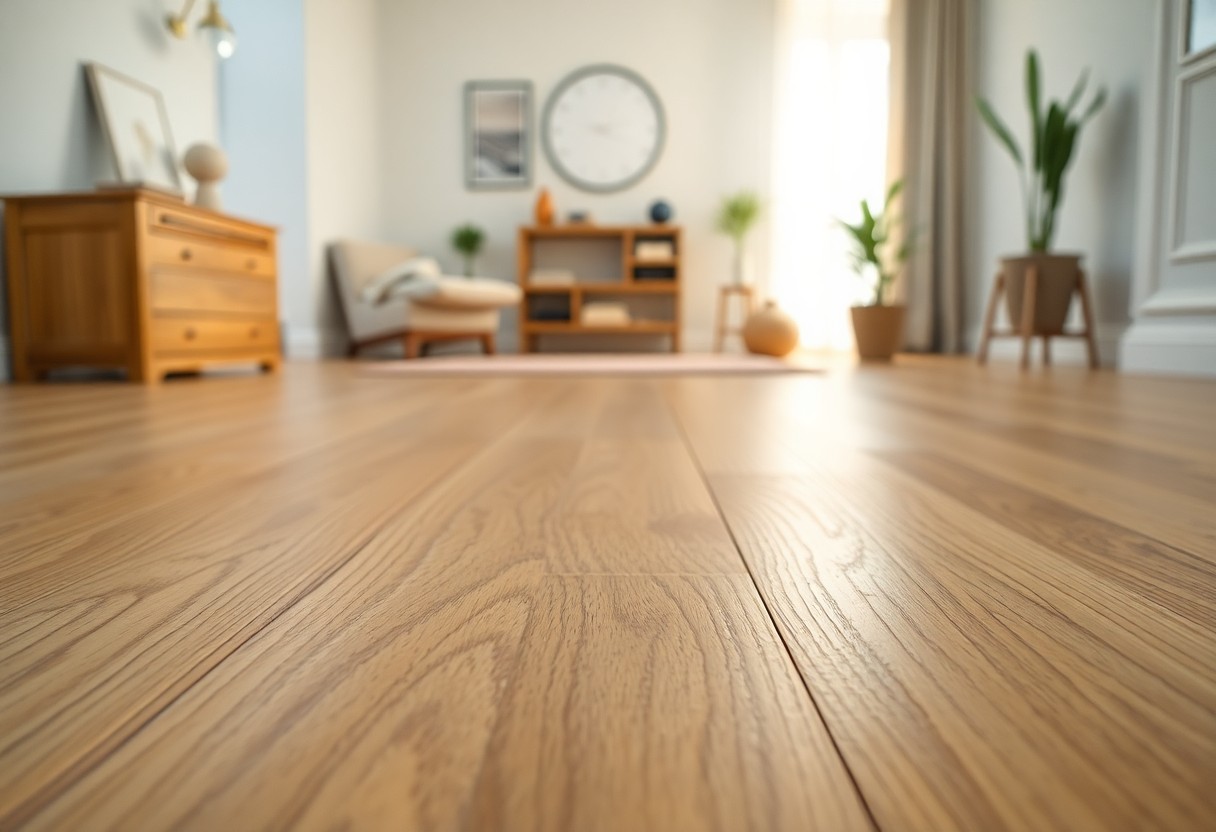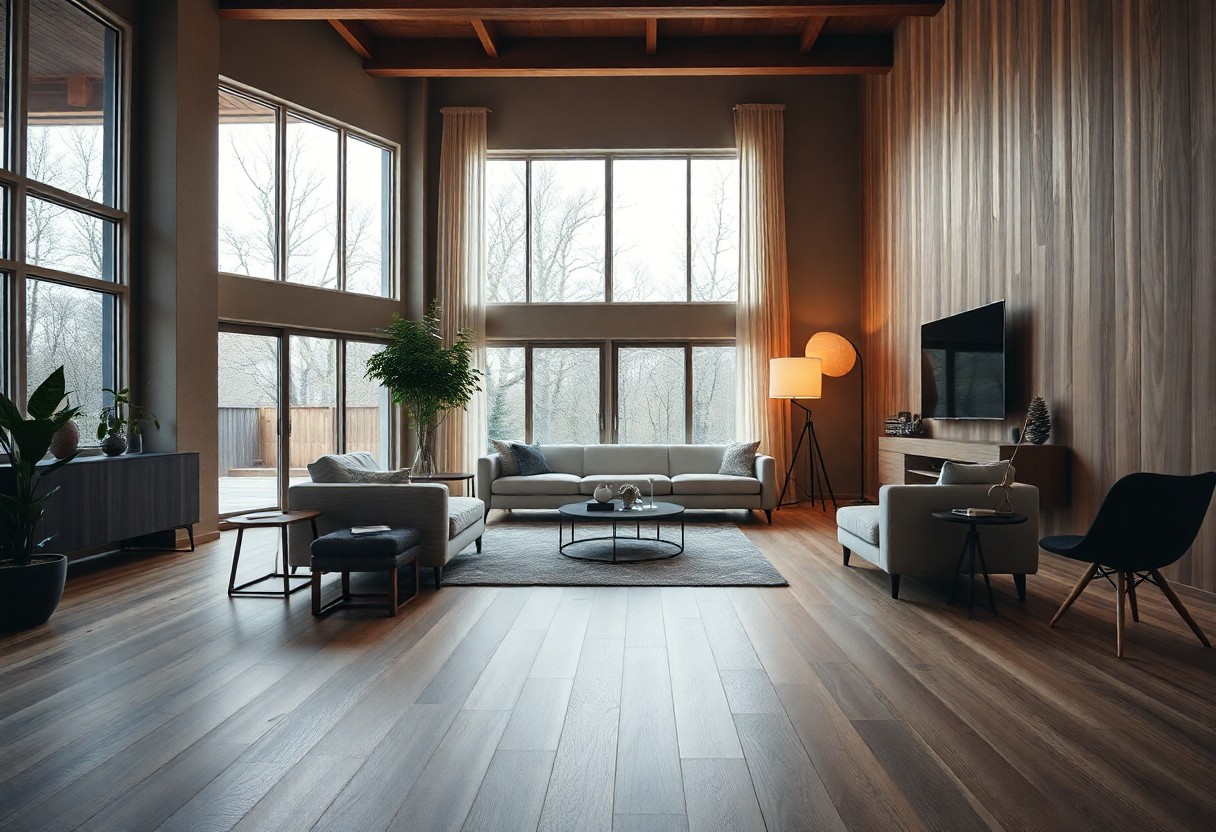White oak flooring offers you a blend of elegance and durability, making it an excellent choice for any home decor. You can enjoy the natural beauty of this hardwood with its rich grain patterns and warm tones that complement both traditional and modern aesthetics. Its versatility allows you to create a serene retreat or a vibrant gathering space, adapt your flooring as your style evolves, and ensure your investment stands the test of time. Dive into the world of white oak flooring to discover how it can transform your living space into a stunning showcase of timeless beauty.
The Allure of White Oak: A Design Staple
White oak flooring stands as an iconic choice for homeowners seeking a blend of aesthetic appeal and practical benefits. Its timeless characteristics and rich hues allow it to seamlessly integrate into both traditional and contemporary spaces. The appeal of white oak lies not just in its visual allure, but also in its remarkable strength, ensuring longevity underfoot. You’ll find that white oak can elevate your home’s ambiance while providing a solid foundation that withstands the test of time.
Versatility Across Aesthetic Trends
Your choice of white oak flooring showcases versatility that aligns with various design aesthetics—whether it’s the warm, rustic charm of a farmhouse, the elegant simplicity of modern minimalism, or the refined look of mid-century styles. The range of shades and finishes available allows you to customize the exact look you want, ensuring that your new flooring complements your existing décor effortlessly.
Natural Features That Enhance Ambiance
White oak features a unique grain pattern and rich coloration that contribute significantly to your home’s ambiance. Subtle variations in tone and texture bring depth and character, creating a welcoming environment that resonates with warmth and sophistication. You might notice that the natural luster of white oak interacts beautifully with light, enhancing your space with a luminous quality that elevates both its style and mood.
The natural features of white oak flooring, such as its pronounced grain and ability to show off unique knots and flecks, offer a sophisticated backdrop that transcends mere functionality. This wood’s variations create visual interest, making each plank unique, which in turn tells a story about the environment from which it came. By choosing white oak flooring, you invite an element of nature into your home, fostering an atmosphere that is both calming and inviting—ideal for creating lasting memories with family and friends.

The Structural Superiority of White Oak
White oak is widely regarded for its robust structure, making it an ideal choice for flooring. Its density contributes to exceptional strength and stability, reducing the likelihood of warping or damage over time. With a Janka hardness rating of approximately 1,360, white oak stands strong against scratches and dents, allowing it to maintain its remarkable appearance in high-traffic areas of your home. This natural resistance to wear and tear ensures that your investment in white oak flooring will last for generations, providing both beauty and functionality.
Durability and Longevity for Daily Living
With its excellent durability, white oak flooring stands up to the rigors of everyday life. The refined grain pattern and dense structure guard against the impact of furniture, pet claws, and heavy foot traffic. Unlike softer woods, this flooring option resists scratches and dents, providing you with a long-lasting surface that retains its beauty for years. Maintenance becomes effortless as the inherent hardness allows for easy cleaning, making it perfect for busy households.
Sustainability and Eco-Friendliness as a Modern Priority
Choosing white oak flooring aligns with sustainable living practices, as it is sourced from responsibly managed forests. Not only does it contribute to carbon sequestration, but its long lifespan diminishes the need for replacements. The natural properties of white oak also mean that it can be refinished multiple times, reducing waste and the demand for new materials. Opting for this flooring demonstrates your commitment to eco-friendly choices without sacrificing style or quality.
In addition to its aesthetic charm, white oak’s sustainability stems from responsible forestry practices. Many manufacturers adhere to strict guidelines ensuring that their lumber comes from managed forests, promoting biodiversity and protecting wildlife habitats. White oak’s ability to be refinished extends its life cycle, minimizing environmental impact by reducing the need for frequent replacements. Embracing this flooring option not only beautifies your home but also reflects your values towards responsible living and environmental stewardship.
Making the Right Choice: Grains and Finishes of White Oak
Choosing the right grain pattern and finish for your white oak flooring can significantly impact the overall aesthetic of your home. With varying textures and colors, understanding these elements will help you find the perfect combination that complements your style. You’ll want to consider how the grain and finish harmonize with your existing decor while providing the durability and maintenance requirements suited to your lifestyle.
Understanding the Variety of Grain Patterns
White oak showcases an impressive array of grain patterns, ranging from straight and uniform to more pronounced flecking. Each pattern can evoke a different atmosphere in your space. For instance, a straight grain can create a classic, sleek appearance, while a cathedral grain pattern adds depth and character, making your floors visually captivating. By identifying your preferred aesthetic, you can select a grain pattern that resonates with your design vision.
The Impact of Finish on Color and Texture
The finish you choose can dramatically alter the color and texture of white oak flooring, allowing you to customize it further. Finishes can range from satin to high-gloss, influencing not just appearance but also texture and feel underfoot. Different stains can either enhance the natural hues of the wood or create a completely new look. Opting for a darker stain can bring out rich, warm tones, while a lighter finish may give your space an airy, modern feel.
Your choice of finish also affects the floor’s durability and maintenance. For example, oil-based finishes provide a warm color and rich texture but may require more upkeep, while water-based finishes offer a range of sheens and drying times, often emphasizing the wood’s natural beauty. Additionally, matte finishes tend to hide scratches and dirt more effectively than glossier options, making them practical for high-traffic areas. Aligning the finish with your functional needs and aesthetic preferences will help you achieve a floor that not only looks stunning but also stands the test of time.
Expert Tips for Installation and Maintenance
Installing and maintaining your white oak flooring can be a straightforward process with the right approach and tools. Follow these expert tips to ensure your flooring looks stunning for years to come:
- Use a moisture meter to check the subfloor moisture content.
- Acclimate the planks in the room before installation.
- Opt for proper underlayment to reduce noise and moisture issues.
- Regularly inspect and clean your flooring to maintain its shine.
Assume that proactive maintenance can extend the life of your flooring and preserve its natural beauty.
DIY Installation vs. Professional Help: What You Need to Know
Choosing between DIY installation and hiring professionals hinges on your experience and comfort level with woodworking. While DIY projects can save you money, they require a good grasp of tools and techniques. If you’re confident and prepared to research, you can potentially achieve impressive results. However, if precision is a priority, professional installers bring expertise, ensuring your flooring is laid correctly and efficiently.
Simple Maintenance Practices for Lasting Beauty
Maintaining the beauty of your white oak flooring doesn’t have to be complicated. Regular cleaning and proper care will keep it looking pristine. Utilize a soft broom or vacuum designed for hardwood to avoid scratches. Wipe up spills immediately to prevent warping or staining, and consider using area rugs in high-traffic zones to minimize wear. Additionally, a monthly application of hardwood-specific cleaner can help manage scuff marks and restore shine.
Investing a little time in maintenance goes a long way. Dust and dirt can accumulate quickly, dulling your flooring’s finish. A quick cleaning routine can significantly enhance the appearance of your white oak. Instead of using harsh chemicals, opt for natural solutions that won’t strip the finish. If your flooring starts to lose its luster, refinishing can make it look new again, preserving its charm while ensuring durability. Simple practices, such as placing mats at entry points and regularly polishing your floors, foster lasting beauty.
Cost Considerations: Value Beyond Price
Investing in white oak flooring transcends merely factoring the initial expenses. Its resilience and timeless aesthetic significantly enhance your home’s value over time, proving to be a sound financial decision that pays dividends in both functionality and beauty. Homebuyers are frequently drawn to spaces featuring quality hardwood, making your investment not just a flooring choice but a long-term asset that elevates your property’s market appeal.
Initial Investment versus Long-term Benefits
White oak flooring may come with a higher upfront cost compared to alternatives like laminate or vinyl, but its longevity and ability to withstand wear make it cost-effective in the long run. You can expect these floors to last for decades, often increasing your home’s resale value, while also providing a gorgeous aesthetic that can adapt to changing interior styles without needing replacement.
Factors Influencing Flooring Costs
The price of white oak flooring is influenced by several key factors, including grade, installation complexity, and finish options. The grade of the wood—ranging from select to common—affects its appearance and durability, with higher grades typically commanding higher prices. Additionally, the method of installation, whether DIY or professional, can greatly impact the overall cost. After evaluating these aspects, you can make a more informed decision about your budget.
- Wood grade and quality
- Thickness of the planks
- Geographic location
- Type of finish
- Installation method
Further analysis reveals that geographic location plays a role in the cost you’ll encounter when purchasing white oak flooring. Areas with higher demand or shipping costs may inflate prices, while local manufacturers might offer competitive deals. The thickness of planks can also impact pricing; thicker boards often yield better durability but come at a premium. After you consider these variables, it’s easier to navigate the pricing landscape.
- Market trends and demand
- Length and width of planks
- Environmental factors affecting harvest
- Financing options and discounts
Summing up
Considering all points, white oak flooring offers a blend of timeless beauty and versatility, making it an ideal choice for every style of home. Its durability and natural elegance not only enhance your living space but also adapt seamlessly to your design preferences. Whether you prefer a modern aesthetic or a more traditional look, white oak can elevate your home’s interior while adding value. By choosing white oak flooring, you’re investing in a lasting foundation that will keep your home looking stunning for years to come.





